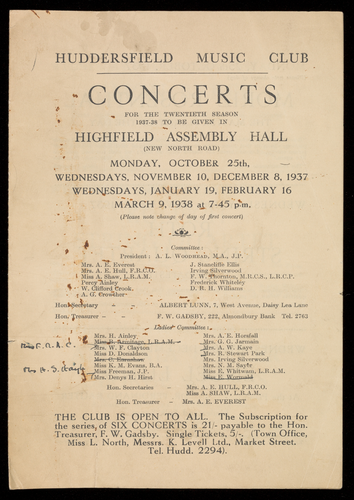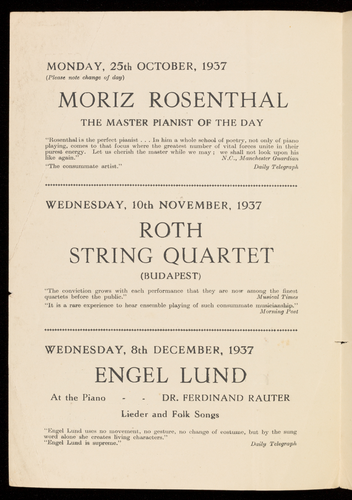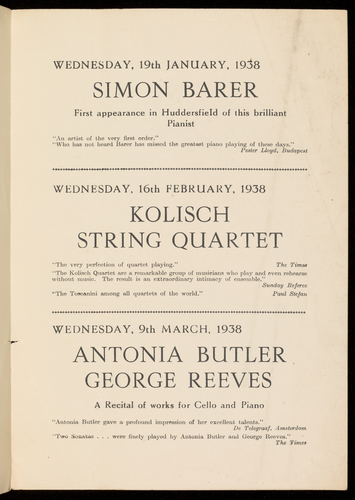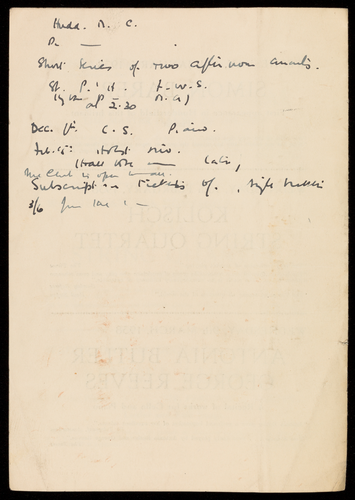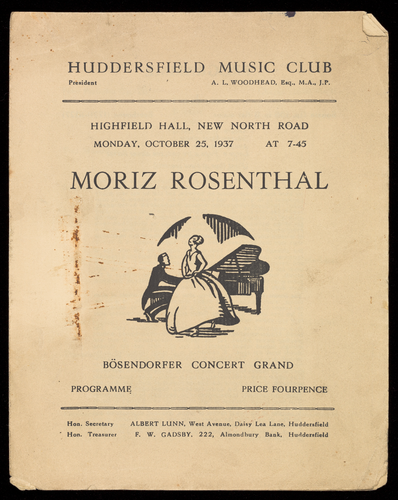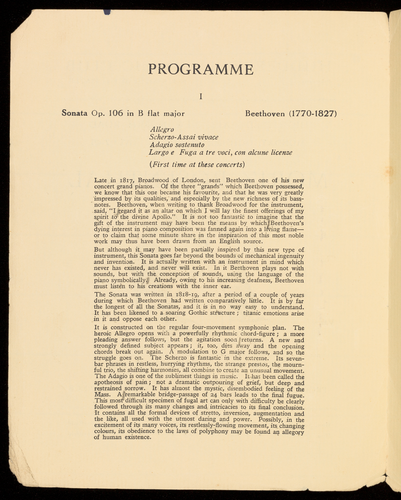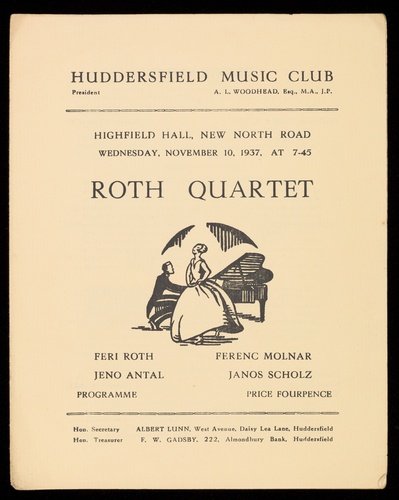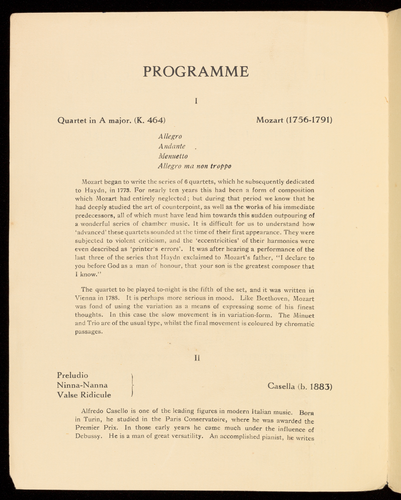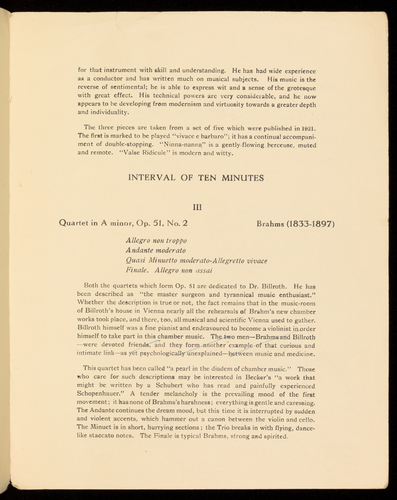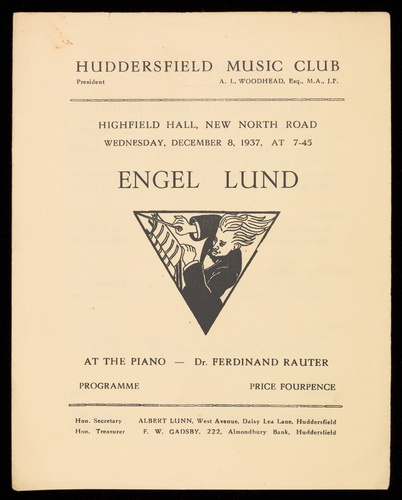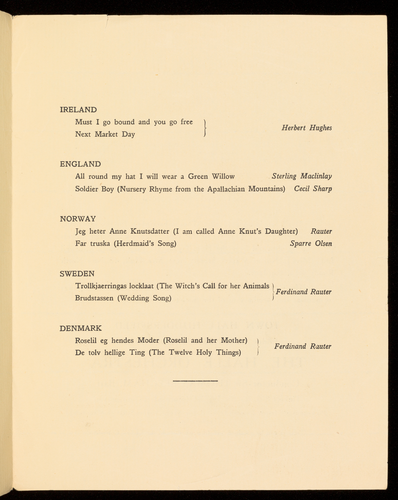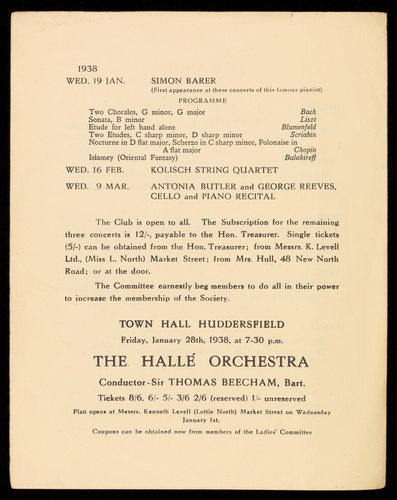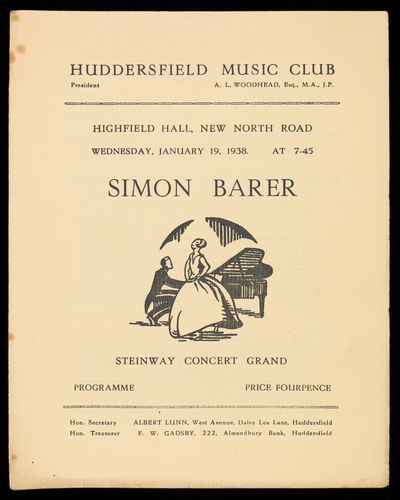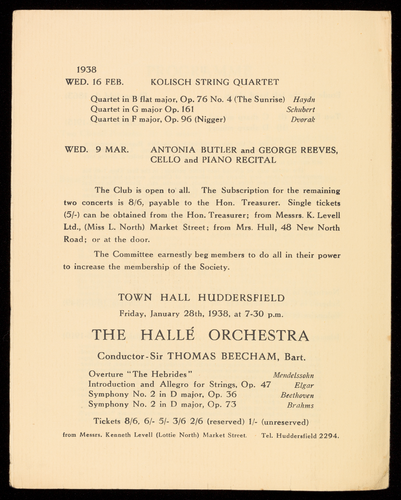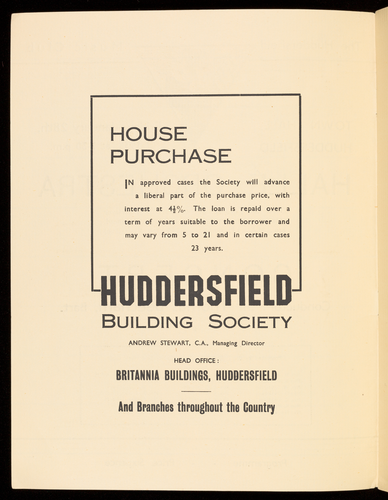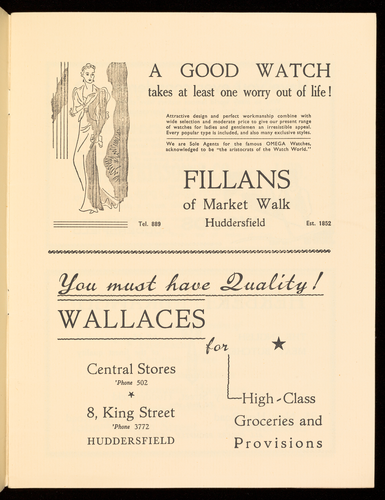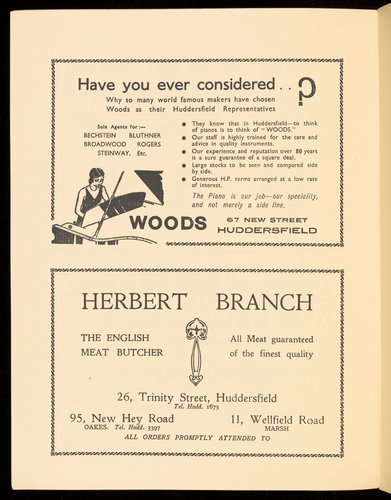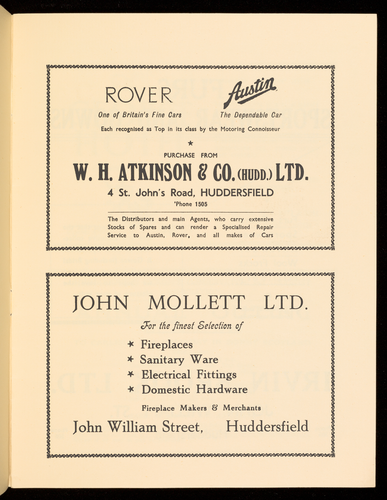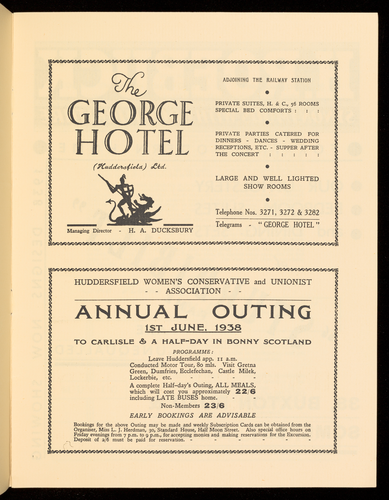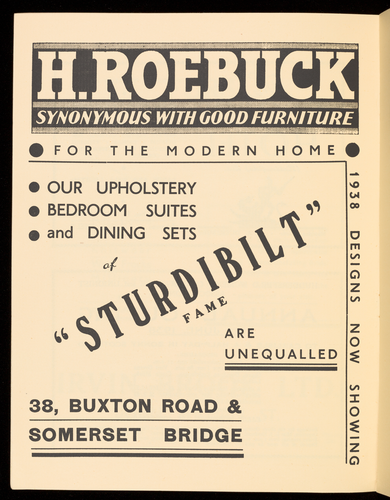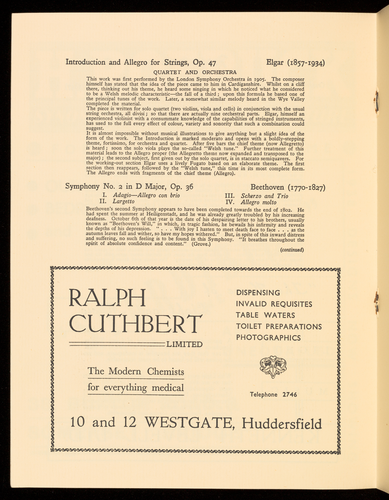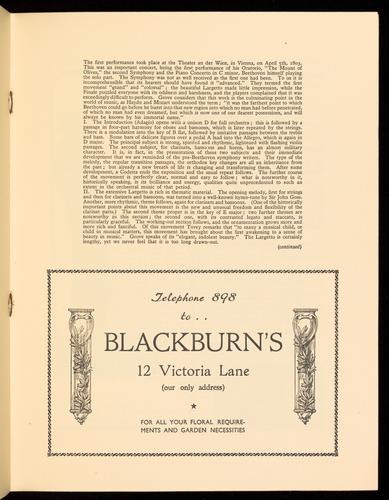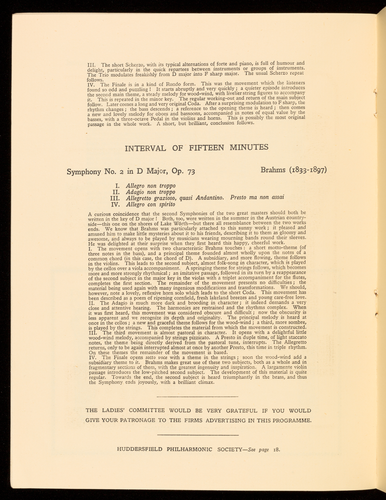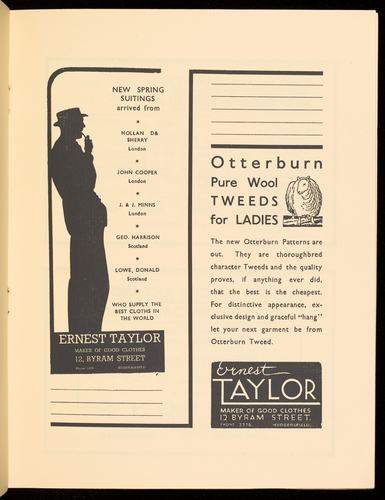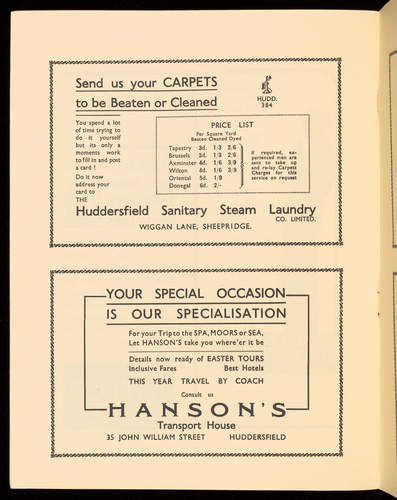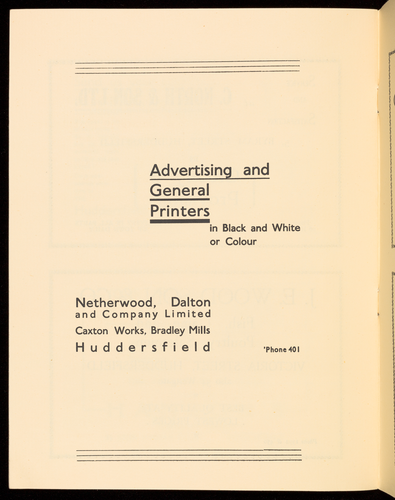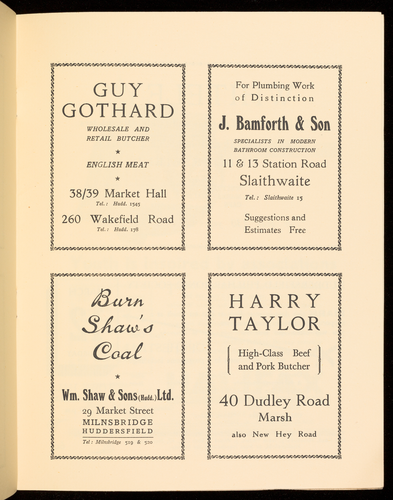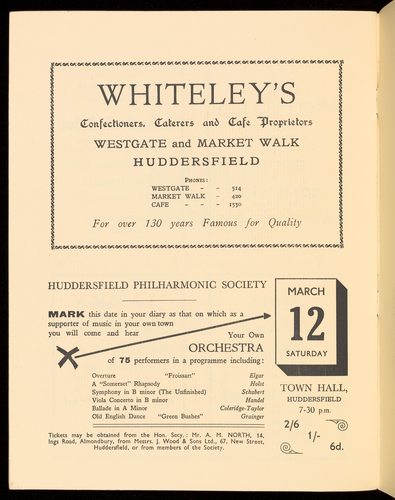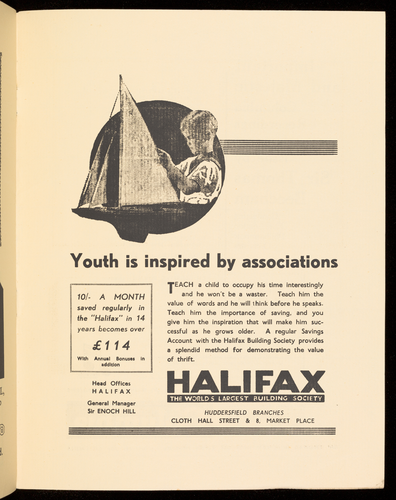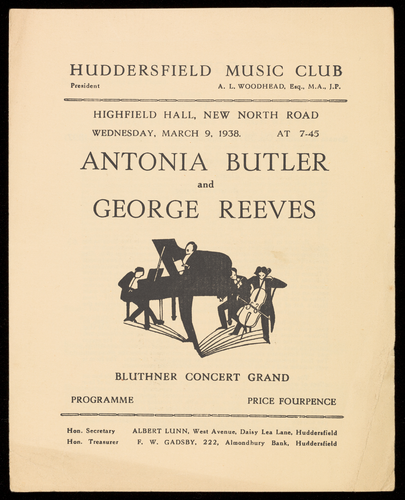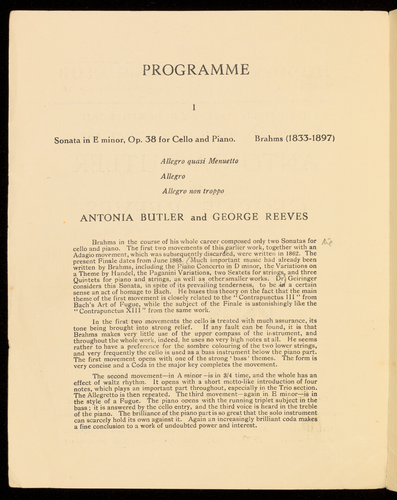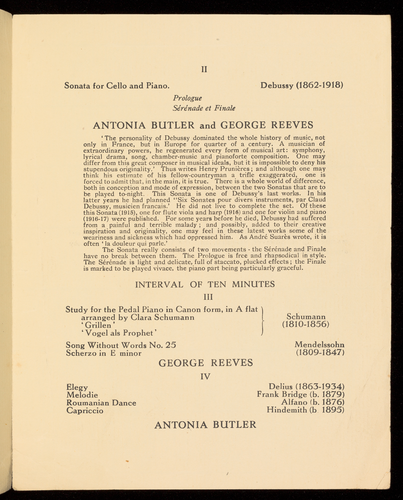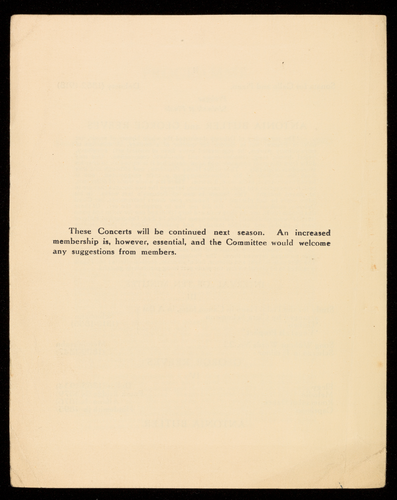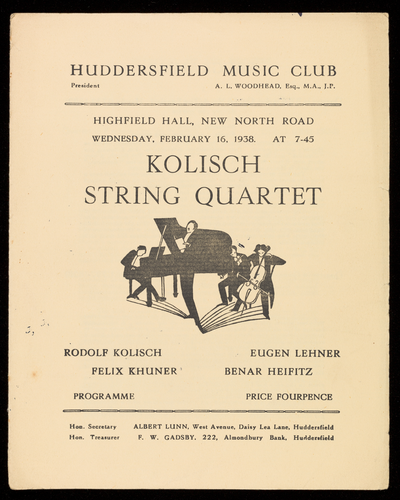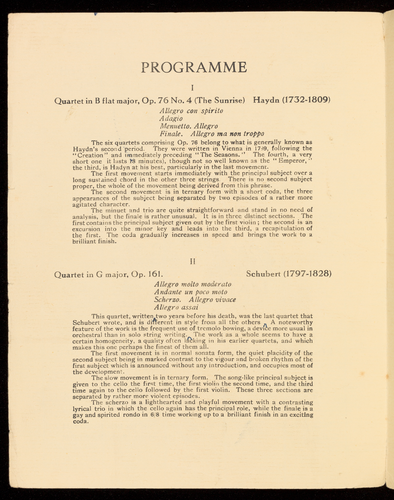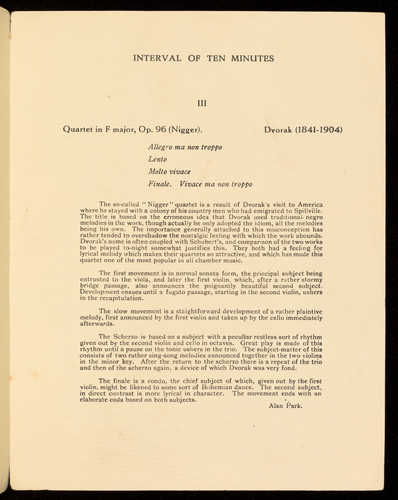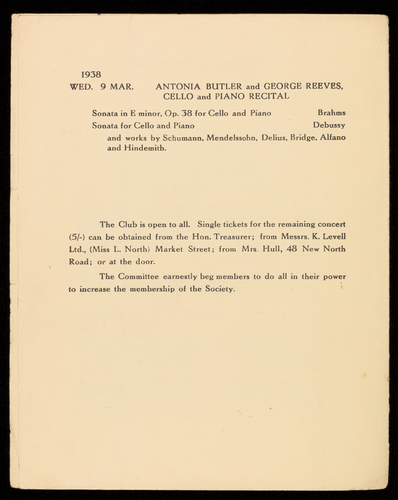Ocr'd Text:
HUDDERSFIELD
CONCERTS
FOR THE TWENTIETH SEASON
1937-38 TO BE GIVEN IN
HIGHFIELD ASSEMBLY HALL
(NEW NORTH ROAD)
MONDAY, OCTOBER 25th,
WEDNESDAYS, NOVEMBER 10, DECEMBER 8, 1937-
WEDNESDAYS, JANUARY 19, FEBRUARY 16
MARCH 9, 1938 at 7-45 pm,
(Please note change of day of first concert)
MF.R.A.C.
Mrs. A. E. Everest
Mrs. A. E. Hull, F.R.C.O..
1 Miss A. Shaw, L.R.A.M.
Percy Ainley
Hon Secretary
Hon. Treasurer -
W. Clifford Crook,
A. G. Crowther-
Committee:
President: A. L. WOODHEAD, M.A., J.P.
J. Stancliffe Ellis
The H. S. itayy
MUSIC CLUB
Mrs. H. Ainley.
Miss B. Armitage, L.R.A.M.
Mrs. W. F. Clayton
Miss D. Donaldson
Mrs. C. Earnshaw
Miss K. M. Evans, B.A.
Miss Freeman, J.P.
Mrs. Denys H. Hirst
Hon. Secretaries
ALBERT LUNN, 7, West Avenue, Daisy Lea Lane
F. W. GADSBY, 222, Almondbury Bank Tel. 2763
Ladies Committee:.
Hon. Treasurer
1
Irving Silverwood
F. W. Thornton, M.R.C.S., L.R.C.P.
Frederick Whiteley
D. R. H. Williams
Mrs. A. E. Horsfall
Mrs. G. G. Jarmain
Mrs. A. W. Kaye
Mrs. R. Stewart Park
Mrs. Irving Silverwood
Mrs. N. M. Sayer
Miss E. Whitwam, L.R.A.M.
Miss E. Wormald
Mrs. A. E. HULL, F.R.C.O.
Miss A. SHAW, L.R.A.M.
Mrs. A. E. EVEREST
THE CLUB IS OPEN TO ALL. The Subscription for
the series, of SIX CONCERTS is 21/- payable to the Hon.
Treasurer, F. W. Gadsby. Single Tickets, 5/-. (Town Office,
Miss L. North, Messrs. K. Levell Ltd., Market Street.
Tel. Hudd. 2294).
Ocr'd Text:
MONDAY, 25th OCTOBER, 1937
(Please note change of day)
MORIZ ROSENTHAL
THE MASTER PIANIST OF THE DAY
"Rosenthal is the perfect pianist. . . In him a whole school of poetry, not only of piano
playing, comes to that focus where the greatest number of vital forces unite in their
purest energy. Let us cherish the master while we may; we shall not look upon his
like again."
N.C., Manchester Guardian
Daily Telegraph
"The consummate artist."
WEDNESDAY, 10th NOVEMBER, 1937
ROTH
STRING QUARTET
(BUDAPEST)
"The conviction grows with each performance that they are now among the finest
quartets before the public."
Musical Times
"It is a rare experience to hear ensemble playing of such consummate musicianship."
Morning Post
WEDNESDAY, 8th DECEMBER, 1937
ENGEL LUND
At the Piano
DR. FERDINAND RAUTER
Lieder and Folk Songs
"Engel Lund uses no movement, no gesture, no change of costume, but by the sung
word alone she creates living characters."
"Engel Lund is supreme."
Daily Telegraph
Ocr'd Text:
WEDNESDAY, 19th JANUARY, 1938
SIMON BARER
First appearance in Huddersfield of this brilliant
Pianist
"An artist of the very first order."
"Who has not heard Barer has missed the greatest piano playing of these days."
Pester Lloyd, Budapest
WEDNESDAY, 16th FEBRUARY, 1938
KOLISCH
STRING QUARTET
"The very perfection of quartet playing."
The Times
"The Kolisch Quartet are a remarkable group of musicians who play and even rehearse
without music. The result is an extraordinary intimacy of ensemble."
"The Toscanini among all quartets of the world."
Sunday Referee
Paul Stefan
WEDNESDAY, 9th MARCH, 1938
ANTONIA BUTLER
GEORGE REEVES
A Recital of works for Cello and Piano
"Antonia Butler gave a profound impression of her excellent talents."
De Telegraaf, Amsterdam
... were finely played by Antonia Butler and George Reeves."
The Times
"Two Sonatas ..
Ocr'd Text:
Huda. I. c.
P
Short series of Two
St. P.' it.
"
15 al 2.30
V
Dec. V.
tub. 8:
The Chat is open
и есл
Subscript:
3/6 fun le
C. S.
ist.
(там ин
ما
230
(
Two affin
t.w.s.
n. a)
. سنه و
nio.
a
A
4
Ficks of.
an
non amcity.
Lalin,
за плей
Ocr'd Text:
Or
HUDDERSFIELD MUSIC CLUB
A. L. WOODHEAD, Esq., M.A., J.P.
President
HIGHFIELD HALL, NEW NORTH ROAD
MONDAY, OCTOBER 25, 1937
AT 7-45
MORIZ ROSENTHAL
BÖSENDORFER CONCERT GRAND
PROGRAMME
PRICE FOURPENCE
Hon. Secretary ALBERT LUNN, West Avenue, Daisy Lea Lane, Huddersfield
Hon. Treasurer
F. W. GADSBY, 222, Almondhury Bank, Huddersfield
Ocr'd Text:
PROGRAMME
I
Sonata Op. 106 in B flat major
Allegro
Scherzo-Assai vivace
Beethoven (1770-1827)
Adagio sostenuto
Largo e Fuga a tre voci, con alcune licenze
(First time at these concerts)
Late in 1817, Broadwood of London, sent Beethoven one of his new
concert grand pianos. Of the three "grands" which Beethoven possessed,
we know that this one became his favourite, and that he was very greatly
impressed by its qualities, and especially by the new richness of its bass-
notes. Beethoven, when writing to thank Broadwood for the instrument,
said, "I regard it as an altar on which I will lay the finest offerings of my
spirit to the divine Apollo." It is not too fantastic to imagine that the
gift of the instrument may have been the means by which Beethoven's
dying interest in piano composition was fanned again into a living flame-
or to claim that some minute share in the inspiration of this most noble
work may thus have been drawn from an English source.
-
But although it may have been partially inspired by this new type of
instrument, this Sonata goes far beyond the bounds of mechanical ingenuity
and invention. It is actually written with an instrument in mind which
never has existed, and never will exist. In it Beethoven plays not with
sounds, but with the conception of sounds, using the language of the
piano symbolically. Already, owing to his increasing deafness, Beethoven
must listen to his creations with the inner ear.
The Sonata was written in 1818-19, after a period of a couple of years
during which Beethoven had written comparatively little. It is by far
the longest of all the Sonatas, and it is in no way easy to understand.
It has been likened to a soaring Gothic structure; titanic emotions arise
in it and oppose each other.
Its seven-
It is constructed on the regular four-movement symphonic plan. The
heroic Allegro opens with a powerfully rhythmic chord-figure; a more
pleading answer follows, but the agitation soon returns. A new and
strongly defined subject appears; it, too, dies away and the opening
chords break out again. A modulation to G major follows, and so the
struggle goes on. The Scherzo is fantastic in the extreme.
bar phrases in restless, hurrying rhythms, the strange prestos, the mourn-
ful trio, the shifting harmonies, all combine to create an unusual movement.
The Adagio is one of the sublimest things in music. It has been called the
apotheosis of pain; not a dramatic outpouring of grief, but deep and
restrained sorrow. It has almost the mystic, disembodied feeling of the
Mass. A remarkable bridge-passage of 24 bars leads to the final fugue.
This most difficult specimen of fugal art can only with difficulty be clearly
followed through its many changes and intricacies to its final conclusion.
It contains all the formal devices of stretto, inversion, augmentation and
the like, all used with the utmost daring and power. Possibly, in the
excitement of its many voices, its restlessly-flowing movement, its changing
colours, its obedience to the laws of polyphony may be found an allegory
of human existence.
Ocr'd Text:
Four Preludes Op. 28
Two Mazurkas
F sharp major
B major
F major
E flat major
Scherzo Op. 31 in B flat minor
Chant Polonaise
Op. 63 in B major
Op. 33 in D major
II
Chopin created an entirely new form with his four Scherzi. They certainly
bear no relation whatever to Beethoven's. But whereas the latter's
certainly possess a boisterous, if sometimes a somewhat bitter, humour,
those of Chopin's are far removed from any such feeling. They are
rather a kind of dramatic or romantic legend. Schumann compared
this second Scherzo to a poem of Byron's, "so tender, so bold, as full of
love as of scorn."
Valse Oubliée in F sharp major
INTERVAL OF TEN MINUTES
Transcendental Study in F minor
Chopin (1810-1849)
III
Chopin-Liszt
One of a set of three Valses oubliées, written between 1879-86
Papillons
Fantasy on themes from Gounod's Faust
(First performance in England)
Liszt (1811-1886)
This is No. 10 of the set of 12 Transcendental Studies. These form
one of the most important, and unsurpassed, contributions to the art of
piano virtuosity ever written. Stupendously difficult to play, when they
are interpreted by a great artist the listener is tempted to overlook the
hardships and to concentrate exclusively on their beauty and music.
Moriz Rosenthal
Ocr'd Text:
1937
WED. 10 NOV.
WED. 8 DEC.
1938
WED. 19 JAN.
WED. 16 FEB.
WED. 9 MAR.
ROTH STRING QUARTET
Quartet in A major K. 464
Preludio
Ninna-Nanna
Mozart
Casella
Valse Ridicule
Quartet in A minor Op. 51 No. 2
Brahms
ENGEL LUND. LIEDER and FOLK SONGS
SIMON BARER
(First appearance at these concerts of this famous pianist)
KOLISCH STRING QUARTET
ANTONIA BUTLER and GEORGE REEVES,
CELLO and PIANO RECITAL
The Club is open to all. The Subscription for the remaining
five concerts is 18/-, payable to the Hon. Treasurer. Single tickets
(5/-) can be obtained from the Hon. Treasurer; from Messrs. K. Levell
Ltd., (Miss L. North) Market Street; from Mrs. Hull, 48 New North
Road; or at the door.
The Committee earnestly beg members to do all in their power
to increase the membership of the Society.
CONCERT and AMERICAN TEA
Organized by the Ladies' Committee, on
WEDNESDAY, 17th NOVEMBER, from 3 to 6 p.m.
in the Huddersfield Women's Conservative and Unionist Association
Rooms, Standard House, Half Moon Street.
Ocr'd Text:
HUDDERSFIELD MUSIC CLUB
A. L. WOODHEAD, Esq., M.A., J.P.
President
HIGHFIELD HALL, NEW NORTH ROAD
WEDNESDAY, NOVEMBER 10, 1937, AT 7-45
ROTH QUARTET
FERI ROTH
JENO ANTAL
PROGRAMME
Hon. Secretary
Hon. Treasurer
2
FERENC MOLNAR
JANOS SCHOLZ
PRICE FOURPENCE
ALBERT LUNN, West Avenue, Daisy Lea Lane, Huddersfield
F. W. GADSBY, 222, Almondhury Bank, Huddersfield
Ocr'd Text:
PROGRAMME
Quartet in A major. (K. 464)
I
Allegro
Andante
Menuetto
Allegro ma non troppo
Mozart (1756-1791)
Mozart began to write the series of 6 quartets, which he subsequently dedicated
to Haydn, in 1773. For nearly ten years this had been a form of composition
which Mozart had entirely neglected; but during that period we know that he
had deeply studied the art of counterpoint, as well as the works of his immediate
predecessors, all of which must have lead him towards this sudden outpouring of
a wonderful series of chamber music. It is difficult for us to understand how
'advanced' these quartets sounded at the time of their first appearance. They were
subjected to violent criticism, and the 'eccentricities' of their harmonies were
even described as 'printer's errors'. It was after hearing a performance of the
last three of the series that Haydn exclaimed to Mozart's father, "I declare to
you before God as a man of honour, that your son is the greatest composer that
I know."
The quartet to be played to-night is the fifth of the set, and it was written in
Vienna in 1785. It is perhaps more serious in mood. Like Beethoven, Mozart
was fond of using the variation as a means of expressing some of his finest
thoughts. In this case the slow movement is in variation-form. The Minuet
and Trio are of the usual type, whilst the final movement is coloured by chromatic
passages.
II
Preludio
Ninna-Nanna
Valse Ridicule
Alfredo Casello is one of the leading figures in modern Italian music. Born
in Turin, he studied in the Paris Conservatoire, where he was awarded the
Premier Prix. In those early years he came much under the influence of
Debussy. He is a man of great versatility. An accomplished pianist, he writes
Casella (b. 1883)
1
1
Ocr'd Text:
for that instrument with skill and understanding. He has had wide experience
as a conductor and has written much on musical subjects. His music is the
reverse of sentimental; he is able to express wit and a sense of the grotesque
with great effect. His technical powers are very considerable, and he now
appears to be developing from modernism and virtuosity towards a greater depth
and individuality.
The three pieces are taken from a set of five which were published in 1921.
The first is marked to be played "vivace e barbaro"; it has a continual accompani-
ment of double-stopping. "Ninna-nanna" is a gently-flowing berceuse, muted
and remote. "Valse Ridicule" is modern and witty.
INTERVAL OF TEN MINUTES
Quartet in A minor, Op. 51, No. 2
Allegro non troppo
Andante moderato
III
Brahms (1833-1897)
Quasi Minuetto moderato-Allegretto vivace
Finale. Allegro non assai
Both the quartets which form Op. 51 are dedicated to Dr. Billroth. He has
been described as "the master surgeon and tyrannical music enthusiast."
Whether the description is true or not, the fact remains that in the music-room
of Billroth's house in Vienna nearly all the rehearsals of Brahm's new chamber
works took place, and there, too, all musical and scientific Vienna used to gather.
Billroth himself was a fine pianist and endeavoured to become a violinist in order
himself to take part in this chamber music. The two men-Brahms and Billroth
-were devoted friends, and they form another example of that curious and
intimate link-as yet psychologically unexplained-between music and medicine.
This quartet has been called "a pearl in the diadem of chamber music." Those
who care for such descriptions may be interested in Becker's "a work that
might be written by a Schubert who has read and painfully experienced
Schopenhauer." A tender melancholy is the prevailing mood of the first
movement; it has none of Brahms's harshness; everything is gentle and caressing.
The Andante continues the dream mood, but this time it is interrupted by sudden
and violent accents, which hammer out a canon between the violin and cello.
The Minuet is in short, hurrying sections; the Trio breaks in with flying, dance-
like staccato notes. The Finale is typical Brahms, strong and spirited.
Ocr'd Text:
1937
WED. 8 DEC.
1938
WED. 19 JAN.
WED. 16 FEB.
WED. 9 MAR.
ENGEL LUND. LIEDER and FOLK SONGS
SIMON BARER
(First appearance at these concerts of this famous pianist)
KOLISCH STRING QUARTET
ANTONIA BUTLER and GEORGE REEVES,
CELLO and PIANO RECITAL
The Club is open to all. The Subscription for the remaining
four concerts is 15/-, payable to the Hon. Treasurer. Single tickets
(5/-) can be obtained from the Hon. Treasurer; from Messrs. K. Levell
Ltd., (Miss L. North) Market Street; from Mrs. Hull, 48 New North
Road; or at the door.
The Committee earnestly beg members to do all in their power
to increase the membership of the Society.
CONCERT and AMERICAN TEA
Organized by the Ladies' Committee, on
WEDNESDAY, 17th NOVEMBER, from 3 to 6 p.m.
in the Huddersfield Women's Conservative and Unionist Association
Rooms, Standard House, Half Moon Street.
ENTRANCE, TEA and CONCERT 1/3
(Will any member not having received an invitation please communicate with Mrs. Hull.)
Ocr'd Text:
HUDDERSFIELD MUSIC CLUB
A. L. WOODHEAD, Esq., M.A., J.P.
President
HIGHFIELD HALL, NEW NORTH ROAD
WEDNESDAY, DECEMBER 8, 1937, AT 7-45
ENGEL LUND
AT THE PIANO - Dr. FERDINAND RAUTER
PROGRAMME
Hon. Secretary
Hon. Treasurer
PRICE FOURPENCE
ALBERT LUNN, West Avenue, Daisy Lea Lane, Huddersfield
F. W. GADSBY, 222, Almondhury Bank, Huddersfield
25
Ocr'd Text:
FOLK SONGS OF MANY LANDS
ICELAND
Ein sit eg uti a steini (I sat alone on the Rock)
Fifilbrekka (The Bank of Dandelion)
Bi bi og blaka (Cradle Song)
Thad er svo margt (Feasting Song)
GERMANY
PROGRAMME
Marienrosen (The Roses of Mary)
Die Vögelhochzeit (The Birds' Wedding)
CZECHOSLOVAKIA
Az ja pojedu (Love Song)
Ciaze je to rolicka (Peasant Song)
FRANCE
Pierre et sa Mie (Ballad)
La Cigale et la Fourmi (The Cricket and the Ant
YIDDISH
Diregelt (The Rent)
Du solst nit gein (Love Song)
Hamawdil (Prayer of a Jewish Woman)
Der rebe Eli Melech (Dancing Song)
Arranged by
S. Einarsson
Sveinbjoernsson
P. Kickstat
Ferdinand Rauter
Ferdinand Rauter
Vitezslav Novak
Julien Tierosot
Roskin
Ferdinand Rauter
Felix de Nobel
Felix de Nobel
Ocr'd Text:
IRELAND
Must I go bound and you go free
Next Market Day
}
ENGLAND
All round my hat I will wear a Green Willow
Sterling Maclinlay
Soldier Boy (Nursery Rhyme from the Apallachian Mountains) Cecil Sharp
SWEDEN
NORWAY
Jeg heter Anne Knutsdatter (I am called Anne Knut's Daughter) Rauter
Far truska (Herdmaid's Song)
Sparre Olsen
Herbert Hughes
Trollkjaerringas locklaat (The Witch's Call for her Animals
Brudstassen (Wedding Song)
DENMARK
Roselil eg hendes Moder (Roselil and her Mother)
De tolv hellige Ting (The Twelve Holy Things)
Ferdinand Rauter
Ferdinand Rauter
Ocr'd Text:
1938
WED. 19 JAN.
Two Chorales, G minor, G major
Sonata, B minor
Etude for left hand alone
SIMON BARER
(First appearance at these concerts of this famous pianist)
PROGRAMME
Islamey (Oriental
Two Etudes, C sharp minor, D sharp minor
Nocturne in D flat major, Scherzo in C sharp minor, Polonaise in
WED. 16 FEB.
WED. 9 MAR.
A flat major
Fantasy)
KOLISCH STRING QUARTET
Blumenfeld
Scriabin
Bach
Liszt
ANTONIA BUTLER and GEORGE REEVES,
CELLO and PIANO RECITAL
Chopin
Balakireff
The Club is open to all. The Subscription for the remaining
three concerts is 12/-, payable to the Hon. Treasurer. Single tickets
(5/-) can be obtained from the Hon. Treasurer; from Messrs. K. Levell
Ltd., (Miss L. North) Market Street; from Mrs. Hull, 48 New North
Road; or at the door.
TOWN HALL HUDDERSFIELD
Friday, January 28th, 1938, at 7-30 p.m.
The Committee earnestly beg members to do all in their power
to increase the membership of the Society.
THE HALLE
HALLE ORCHESTRA
Conductor - Sir THOMAS BEECHAM, Bart.
Tickets 8/6, 6/- 5/- 3/6 2/6 (reserved) 1/- unreserved
Plan opens at Messrs. Kenneth Levell (Lottie North) Market Street on Wednesday
January 1st.
Coupons can be obtained now from members of the Ladies' Committee
Ocr'd Text:
HUDDERSFIELD MUSIC CLUB
A. L. WOODHEAD, Esq., M.A., J.P.
President
HIGHFIELD HALL, NEW NORTH ROAD
WEDNESDAY, JANUARY 19, 1938.
SIMON BARER
PROGRAMME
AT 7-45
||||
STEINWAY CONCERT GRAND
Hon. Secretary
Hon. Treasurer
PRICE FOURPENCE
ALBERT LUNN, West Avenue, Daisy Lea Lane, Huddersfield
F. W. GADSBY, 222, Almondbury Bank, Huddersfield
Ocr'd Text:
Two Choral Preludes (1) G minor)
(II) G major)
Sonata in B minor
PROGRAMME
&
Bach (1685-1750)
Liszt (1811-1886)
Lento assai - Allegro energico - Andante sostenuto - Allegro
energico Stretta quasi Presto - Allegro moderato.
"If we wished to describe Liszt's Sonata in a word we should say
"Dramatic."... There is not a figure, not a phase, which is not derived from one
of the principal motives. If similar thematic labour were the work of a
Beethoven or a Schumann we would speak of it only in tones of breathless
admiration. This man who toiled so magnificently for music and for his
instrument, here presents us with the first example of a Sonata in one
movement, an idea destined to inspire so many succeeding composers. From
the expressive point of view I see in its symphonic unfolding an illustration of
Goethe's Faust. Liszt has summed up all the feelings of Faust in this Sonata-
despair, ardour, enthusiasm, reverie, tenderness and irony." These short
extracts from Cortot's writings express in a few words the general impression
of the Sonata and its historical importance.
After
The Sonata was composed in 1853, during the period when Liszt was
engaged in the production of his symphonic poems. It is planned in one
movement, but the successive changes of tempo correspond roughly to the
regular sonata-form, without breaking the continuity. The Introduction
consists of seven bars, in which a descending motif is heard, becoming a kind
of motto-theme to the work. The Allegro has two themes, one in leaping
octaves, the second, a Lisztian version of "Fate knocking at the door."
development, another entry of the motto-theme leads to an expressive second
subject, cantando espressivo. A big climax eompletes the first section. The
tempo changes to Andante sostenuto; here three subjects appear, one in F
sharp being new. The Motto-theme again introduces the Allegro. A fugato
follows; again, the Allegro; then a Stretta which quickens to Prestissimo. A
few bars of Andante introduce the epilogue; the "Knocking theme" with
chords above it. Last of all the motto-theme, now quiet and peaceful.
Ocr'd Text:
Etude for the left hand alone.
Two Etudes (I) C sharp minor)
(II) D sharp minor)
II
Blumenfeld (b. 1863)
Scriabin is one of the most remarkable of modern Russian composers.
He was a pupil of Taneiev (composition) and Safonov (piano). Later he became
a teacher in the Moscow Conservatoire but soon retired in order to devote him-
self entirely to composition.
Nocturne in D flat major, Op. 27
Scherzo in C sharp minor, Op. 39
Polonaise in A flat major, Op. 53
Scriabin (1871-1915)
His works may be divided into three periods; in the first (Opp. 1-40) his
compositions show very clearly the influence of Chopin, even to his use of the
characteristic Chopin titles, prelude, study, mazurka, etc. Even in the earliest
examples he shows an amazing mastery of subtle keyboard effect, which some-
times equals, and later surpasses, that of Chopin's. But Scriabin's work has an
erotic, morbid, almost poisonous quality, very different from the older master.
The second period (up to Op. 52) shows his art becoming more complex
as he discovered new emotional and harmonic effects. In the third period, he
became obsessed with the expression in music of theosophical ideas; in the
latest works of all he reaches a pitch of obscurity which even his most fervent
admirers find difficult to comprehend.
INTERVAL OF TEN MINUTES
III
Chopin (1810-1849)
Islamey (Oriental Fantasy)
Balakirev (1836-1910)
Balakirev was the composer and teacher to whom the nationalist school
of Russian music in the nineteenth century owed its formation. Born at Nijny-
Novgorod, he came as a young man to St. Petersburg, where Glinka, the father
of modern Russian music, was much impressed with him and hailed him as his
successor. Later he became the leader of the group of "Five"-Balakirev, Cui,
Mussorgsky, Rimsky-Korsakov and Borodin. In 1869 he was appointed
conductor of the Imperial Russian Musical Society, and thus he was able to
introduce new works, both native and foreign, of the greatest importance. He
was also a fine pianist. The number of his compositions is not very great, but
all of them show the exquisite and finished quality of his inspiration and work-
manship. The fascination of the East is to be found in this Fantasy "Islamey,"
as well as piano composition of great technical brilliancy and delight.
Ocr'd Text:
1938
WED. 16 FEB.
KOLISCH STRING QUARTET
Quartet in B flat major, Op. 76 No. 4 (The Sunrise) Haydn
Quartet in G major Op. 161
Schubert
Quartet in F major, Op. 96 (Nigger)
Dvorak
WED. 9 MAR.
ANTONIA BUTLER and GEORGE REEVES,
CELLO and PIANO RECITAL
The Club is open to all. The Subscription for the remaining
two concerts is 8/6, payable to the Hon. Treasurer. Single tickets
(5/-) can be obtained from the Hon. Treasurer; from Messrs. K. Levell
Ltd., (Miss L. North) Market Street; from Mrs. Hull, 48 New North
Road; or at the door.
The Committee earnestly beg members to do all in their power
to increase the membership of the Society.
TOWN HALL HUDDERSFIELD
Friday, January 28th, 1938, at 7-30 p.m.
THE HALLÉ
HALLE ORCHESTRA
Conductor - Sir THOMAS BEECHAM, Bart.
Overture "The Hebrides"
Introduction and Allegro for Strings, Op. 47
Symphony No. 2 in D major, Op. 36
Symphony No. 2 in D major, Op. 73
Mendelssohn
Elgar
Beethoven
Brahms
Tickets 8/6, 6/- 5/- 3/6 2/6 (reserved) 1/- (unreserved)
from Messrs. Kenneth Levell (Lottie North) Market Street. Tel. Huddersfield 2294.
Ocr'd Text:
The Huddersfield
TOWN HALL,
HUDDERSFIELD
HALLÉ ORCHESTRA
Under the patronage of His Worship the Mayor
(Alderman Alfred Willis, J.P.) and A. L. Woodhead,
Esq., M.A., J.P. (President, Huddersfield Music Club)
Music Club
CONCERT
Conductor: Sir Thomas Beecham, Bart.
Mrs. H. Ainley
Miss B. Armitage, L.R.A.M.
Mrs. W. F. Clayton
Miss D. Donaldson
Mrs. C. Earnshaw
Miss K. M. Evans, B.A.
Miss Freeman, J.P.
Friday, January 28th,
1938, at 7-30 p.m.
Promoted by the Ladies' Committee Huddersfield Music Club
Committee:
Mrs. Denys H. Hirst
Mrs. A. E. Horsfall
Mrs. G. G. Jarmain
Mrs. A. W. Kaye
Mrs. R. Stewart Park
Mrs. N. M. Sayer
Mrs. I. Silverwood
Programme
I
Miss E. Whitwam, L.R.A.M.
Miss E. Wormald
Hon. Secretaries :
Mrs. A. E. Hull, F.R.C.O.
Miss A. Shaw, L.R.A.M.
Hon Treasurer:
Mrs. A. E. Everest
Price Sixpence
N D. & CO., HUDD.
Ocr'd Text:
HOUSE
PURCHASE
IN approved cases the Society will advance
a liberal part of the purchase price, with
interest at 41%. The loan is repaid over a
term of years suitable to the borrower and
may vary from 5 to 21 and in certain cases
23 years.
HUDDERSFIELD
BUILDING SOCIETY
ANDREW STEWART, C.A., Managing Director
HEAD OFFICE :
BRITANNIA BUILDINGS, HUDDERSFIELD
And Branches throughout the Country
Ocr'd Text:
A GOOD
WATCH
takes at least one worry out of life!
Tel. 889
Attractive design and perfect workmanship combine with
wide selection and moderate price to give our present range
of watches for ladies and gentlemen an irresistible appeal.
Every popular type is included, and also many exclusive styles.
'Phone 502
We are Sole Agents for the famous OMEGA Watches,
acknowledged to be "the aristocrats of the Watch World."
Central Stores
You must have Quality!
WALLACES
8, King Street
'Phone 3772
FILLANS
of Market Walk
Huddersfield
HUDDERSFIELD
Est. 1852
for
PORSA
High-Class
Groceries and
Provisions
Ocr'd Text:
550
Have you ever considered..
Why so many world famous makers have chosen
Woods as their Huddersfield Representatives
Sole Agents for :-
BECHSTEIN BLUTHNER
BROADWOOD ROGERS
STEINWAY, Etc.
THE ENGLISH
MEAT BUTCHER
● They know that in Huddersfield-to think
of pianos is to think of "WOODS."
. Our staff is highly trained for the care and
advice in quality instruments.
95, New Hey Road
OAKES. Tel. Hudd. 3397
● Our experience and reputation over 80 years
is a sure guarantee of a square deal.
● Large stocks to be seen and compared side
by side.
Generous H.P. terms arranged at a low rate
of interest.
●
WOODS
Q.
The Piano is our job-our speciality,
and not merely a side line.
67 NEW STREET
HERBERT BRANCH
HUDDERSFIELD
26, Trinity Street, Huddersfield
Tel. Hudd. 1673
All Meat guaranteed
of the finest quality
11, Wellfield Road
MARSH
ALL ORDERS PROMPTLY ATTENDED TO
5
Ocr'd Text:
ROVER
Austin
One of Britain's Fine Cars
The Dependable Car
Each recognised as Top in its class by the Motoring Connoisseur
PURCHASE FROM
W. H. ATKINSON & CO. (HUDD.) LTD.
R
4 St. John's Road, HUDDERSFIELD
'Phone 1505
The Distributors and main Agents, who carry extensive
Stocks of Spares and can render a Specialised Repair
Service to Austin, Rover, and all makes of Cars
JOHN MOLLETT LTD.
For the finest Selection of
* Fireplaces
* Sanitary Ware
* Electrical Fittings
* Domestic Hardware
Fireplace Makers & Merchants
John William Street,
Huddersfield
i
Ocr'd Text:
FURS
SPORTSWEAR AND GOWNS
Furs - Gowns
Sportswear
Knitwear
Wool Frocks
Millinery
Phone
505
FUR repairs under
personal supervision
WE beg to announce that the
new and exclusive collec-
tion of Furs, Sportswear
& Gowns (including Bridal
Wear) is now ready and
we hope to have the
pleasure of your visit
IRVIN BROOK LTD.
JOHN WILLIAM ST.
Huddersfield
Friol Phone
505
Ocr'd Text:
55
5
5
The
GEORGE
HOTEL
(Huddersfiela) Ltd.
Managing Director - H. A. DUCKSBURY
F
ANNUAL
ADJOINING THE RAILWAY STATION
PRIVATE SUITES, H. & C., 56 ROOMS
SPECIAL BED COMFORTS :
PRIVATE PARTIES CATERED FOR
DINNERS
DANCES
WEDDING
RECEPTIONS, ETC. - SUPPER AFTER
―
THE CONCERT
ASSOCIATION
O
LARGE AND WELL LIGHTED
SHOW ROOMS
HUDDERSFIELD WOMEN'S CONSERVATIVE and UNIONIST
Telephone Nos. 3271, 3272 & 3282
Telegrams
GEORGE HOTEL
1
66
PROGRAMME:
Leave Huddersfield app. II a.m.
Conducted Motor Tour, 80 mls. Visit Gretna
Green, Dumfries, Ecclefechan, Castle Milek,
Lockerbie, etc.
OUTING
1ST JUNE, 1938
TO CARLISLE & A HALF-DAY IN BONNY SCOTLAND
A complete Half-day's Outing, ALL MEALS,
which will cost you approximately 22/6
including LATE BUSES home.
Non-Members 23/6
EARLY BOOKINGS ARE ADVISABLE
Bookings for the above Outing may be made and weekly Subscription Cards can be obtained from the
Organiser, Miss L. J. Herdman, 30, Standard House, Half Moon Street. Also special office hours on
Friday evenings from 7 p.m. to 9 p.m., for accepting monies and making reservations for the Excursion.
Deposit of 2/6 must be paid for reservation.
"9
Ocr'd Text:
H.ROEBUCK
SYNONYMOUS WITH GOOD FURNITURE
FOR THE MODERN HOME
OUR UPHOLSTERY
● BEDROOM SUITES
and DINING SETS
of
ARE
99
"STURDIBILT'
FAME
UNEQUALLED
38, BUXTON ROAD &
SOMERSET BRIDGE
1938
DESIGNS NOW SHOWING
Ocr'd Text:
193 8
DESIGNS
Z
O W
{
SHOWING
Programme
GOD SAVE THE KING
Overture The Hebrides (Fingal's Cave) Op. 26
Mendelssohn (1809-1847)
In the summer of 1829 Mendelssohn, with his friend Klingemann, set out on a tour of Scotland.
They first visited Edinburgh, where in Holyroodhouse, seeing the traditional scene of the
murder of Rizzio and the chapel with the altar at which Mary was crowned standing open to
the sky, ruined and decayed, Mendelssohn said "I think there I found the beginning of my
Scotch Symphony." Continuing their journey, they later visited Fingal's Cave, and writing
"on one of the Hebrides" on August 7th, Mendelssohn gives 20 bars of music "to show how
extraordinarily the place affected me." Those twenty bars, compressed into ten, are almost
identical with the opening of the "Hebrides" Overture. The work was not, however, completed
at once. Probably much of it was written during a tour of Italy which Mendelssohn undertook
a year later, for the first version of the score is signed Rome, December 16th, 1830. Mendelssohn
was not yet satisfied with his work, and after a performance of it at a Royal Philharmonic
Society concert, in 1832, he revised the score and the final version is dated London, 1832.
Mendelssohn is a strange figure in musical history. An almost idolatrous worship of his art
during the early-Victorian period was followed by a violent reaction against it. Now the tide
is turning again in his favour, but a more careful discrimination is made between his works of
pure genius and those which are of a less high quality. It must not be forgotten that he died
at the early age of 38; it is impossible to tell in what directions his great genius would have
developed.
The "Hebrides" Overture is definitely to be numbered among Mendelssohn's inspired works.
It has been called "a masterpiece of delicate and polished orchestration"; Wagner surely
understated its worth when he said it was an acquarelle by a great landscape-painter. Although
Mendelssohn was always strongly attracted towards "Programme" music (each Symphony and
Overture has its title), he never sought to attempt too literal a painting; he tries rather to
suggest landscape, colouring, impression or mood. Here, surely, is "Hebridean scenery, the
roar of the waves rolling into the cavern, the cries of the sea-birds, and perhaps almost more
than anything else, the radiant and telescopic clearness of the air when the mist is completely
dissolved or not yet formed." (Tovey)
The Overture opens with a charming, and often repeated, little theme (the theme which was
quoted in the letter); the impression given is that of gently-moving water. Soon the cellos
sing a cantabile second subject; this is repeated, and after a lovely cadence, the first little theme
returns; further development follows. A new theme is heard in the wood-wind over tremolo
strings. The working-out section becomes more stormy, rising to a climax, both of speed and
intensity, in the final section. Five bars from the close, the clarinet enters again with the first
theme and the piece ends with the calm of the opening. The whole work forms a remarkable
and beautiful piece of impressionistic sound-painting.
(cont.)
"The Home of
LIGHT
MUSIC
Light and Music"
A particularly attractive_display of Lamp Shades,
Standards and Electrical Fittings are always on view.
To say that they are beautiful is inadequate, and yet
the prices will be found to be most reasonable.
With Light goes Music . . . and so it is appropriate
that we are able to offer an unbeatable selection of the
most dependable Radio Gramophones. H.M.V.,
Marconiphone, Philips and Pye... Our RECORD
Department has always in stock the very latest issues
of all the leading makes . . . His Master's Voice,
Columbia, Parlophone, Decca and Brunswick.
KENNETH LEVELL LTD.
MARKET STREET, HUDDERSFIELD
Phone
2294
Ocr'd Text:
Introduction and Allegro for Strings, Op. 47
Elgar (1857-1934)
QUARTET AND ORCHESTRA
This work was first performed by the London Symphony Orchestra in 1905. The composer
himself has stated that the idea of the piece came to him in Cardiganshire. Whilst on a cliff
there, thinking out his theme, he heard some singing in which he noticed what he considered
to be a Welsh melodic characteristic-the fall of a third; upon this formula he based one of
the principal tunes of the work. Later, a somewhat similar melody heard in the Wye Valley
completed the material.
The piece is written for solo quartet (two violins, viola and cello) in conjunction with the usual
string orchestra, all divisi; so that there are actually nine orchestral parts. Elgar, himself an
experienced violinist with a consummate knowledge of the capabilities of stringed instruments,
has used to the full every effect of colour, variety and sonority that such a combination could
suggest.
It is almost impossible without musical illustrations to give anything but a slight idea of the
form of the work. The Introduction is marked moderato and opens with a boldly-stepping
theme, fortissimo, for orchestra and quartet. After five bars the chief theme (now Allegretto)
is heard; soon the solo viola plays the so-called "Welsh tune." Further treatment of this
material leads to the Allegro proper (the Allegretto theme now expanded and transposed to the
major); the second subject, first given out by the solo quartet, is in staccato semiquavers. For
the working-out section Elgar uses a lively Fugato based on an elaborate theme. The first
section then reappears, followed by the "Welsh tune," this time in its most complete form.
The Allegro ends with fragments of the chief theme (Allegro).
Symphony No. 2 in D Major, Op. 36
I. Adagio-Allegro con brio
II. Largetto
RALPH
CUTHBERT
Beethoven's second Symphony appears to have been completed towards the end of 1802. He
had spent the summer at Heiligenstadt, and he was already greatly troubled by his increasing
deafness. October 6th of that year is the date of his despairing letter to his brothers, usually
known as "Beethoven's Will," in which, in tragic fashion, he bewails his infirmity and reveals
the depths of his depression.
With joy I hasten to meet death face to face . . . as the
autumn leaves fall and wither, so have my hopes withered." But, in spite of this inward distress
and suffering, no such feeling is to be found in this Symphony. "It breathes throughout the
spirit of absolute confidence and content." (Grove.)
(continued)
LIMITED
Beethoven (1770-1827)
The Modern Chemists
for everything medical
III. Scherzo and Trio
IV. Allegro molto
DISPENSING
INVALID REQUISITES
TABLE WATERS
TOILET PREPARATIONS
PHOTOGRAPHICS
Telephone 2746
10 and 12 WESTGATE, Huddersfield
Ocr'd Text:
1
The first performance took place at the Theater an der Wien, in Vienna, on April 5th, 1803.
This was an important concert, being the first performance of his Oratorio, "The Mount of
Olives," the second Symphony and the Piano Concerto in C minor, Beethoven himself playing
the solo part. The Symphony was not as well received as the first one had been. To us it is
incomprehensible that its hearers should have found it "advanced." They termed the first
movement "grand" and "colossal"; the beautiful Largetto made little impression, while the
Finale puzzled everyone with its oddness and harshness, and the players complained that it was
exceedingly difficult to perform. Grove considers that this work is the culminating point in the
world of music, as Haydn and Mozart understood the term; "it was the farthest point to which
Beethoven could go before he burst into that new region into which no man had before penetrated,
of which no man had even dreamed, but which is now one of our dearest possessions, and will
always be known by his immortal name."
I.
The Introduction (Adagio) opens with a unison D for full orchestra; this is followed by a
passage in four-part harmony for oboes and bassoons, which is later repeated by the strings.
There is a modulation into the key of B flat, followed by imitative passages between the treble
and bass. Some bars of delicate figures over a pedal A lead into the Allegro, which is again in
D major. The principal subject is strong, spirited and rhythmic, lightened with flashing violin
passages. The second subject, for clarinets, bassoons and horns, has an almost military
character.
It is, in fact, in the presentation of these two subjects and their immediate
development that we are reminded of the pre-Beethoven symphony writers. The type of the
melody, the regular transition passages, the orthodox key changes are all an inheritance from
the past; but already a new breath of life is changing and transforming them. After some
development, a Codetta ends the exposition and the usual repeat follows. The further course
of the movement is perfectly clear, normal and easy to follow; what is noteworthy in it,
historically speaking, is its brilliance and energy, qualities quite unprecedented to such an
extent in the orchestral music of that period.
II. The extensive Largetto is rich in thematic material. The opening melody, first for strings
and then for clarinets and bassoons, was turned into a well-known hymn-tune by Sir John Goss.
Another, more rhythmic, theme follows, again for clarinets and bassoons. (One of the historically
important points about this movement is the new and unusual freedom and flexibility of the
clarinet parts.) The second theme proper is in the key of E major; two further themes are
noteworthy in this section; the second one, with its contrasted legato and staccato, is
particularly graceful. The working-out section follows, and the ornamentation grows more and
more rich and fanciful. Of this movement Tovey remarks that "to many a musical child, or
child in musical matters, this movement has brought about the first awakening to a sense of
beauty in music." Grove speaks of its "elegant, indolent beauty." The Largetto is certainly
lengthy, yet we never feel that it is too long drawn-out.
(continued)
ARTINYATOKAN
Telephone 89 8
to..
BLACKBURN'S
12 Victoria Lane
(our only address)
FOR ALL YOUR FLORAL REQUIRE-
MENTS AND GARDEN NECESSITIES
oooti
Ocr'd Text:
III. The short Scherzo, with its typical alternations of forte and piano, is full of humour and
delight, particularly in the quick repartees between instruments or groups of instruments.
The Trio modulates freakishly from D major into F sharp major. The usual Scherzo repeat
follows.
IV. The Finale is in a kind of Rondo form. This was the movement which the listeners
found so odd and puzzling! It starts abruptly and very quickly; a quieter episode introduces
the second main theme, a steady melody for wood-wind, with livelier string figures to accompany
it. This is repeated in the minor key. The regular working-out and return of the main subject
follow. Later comes a long and very original Coda. After a surprising modulation to F sharp, the
rhythm changes; the bass descends; a reference to the opening theme is heard; then comes
a new and lovely melody for oboes and bassoons, accompanied in notes of equal value by the
basses, with a three-octave Pedal in the violins and horns. This is possibly the most original
passage in the whole work. A short, but brilliant, conclusion follows.
INTERVAL OF FIFTEEN MINUTES
III.
IV.
Symphony No. 2 in D Major, Op. 73
I.
Allegro non troppo
II.
Adagio non troppo
Allegretto grazioso, quasi Andantino. Presto ma non assai
Allegro con spirito
Brahms (1833-1897)
A curious coincidence that the second Symphonies of the two great masters should both be
written in the key of D major! Both, too, were written in the summer in the Austrian country-
side this one on the shores of Lake Wörth-but there all resemblance between the two works
ends. We know that Brahms was particularly attached to this sunny work; it pleased and
amused him to make little mysteries about it to his friends, describing it to them as gloomy and
awesome, and always to be played by musicians wearing mourning bands round their sleeves.
He was delighted at their surprise when they first heard this happy, cheerful work.
I. The movement opens with two characteristic Brahms touches: a short motto-theme (of
three notes in the bass), and a principal theme founded almost wholly upon the notes of a
common chord (in this case, the chord of D). A subsidiary, and more flowing, theme follows
in the violins. This leads to the second subject, almost folk-song in character, which is played
by the cellos over a viola accompaniment. A springing theme for strings follows, which becomes
more and more strongly rhythmical; an imitative passage, followed in its turn by a reappearance
of the second subject in the major key in the violas with a triplet accompaniment for the flutes,
completes the first section. The remainder of the movement presents no difficulties; the
material being used again with many ingenious modifications and transformations. We should,
however, note a lovely, reflexive horn solo which leads to the short Coda. This movement has
been described as a poem of ripening cornfield, fresh lakeland breezes and young care-free love.
II. The Adagio is much more dark and brooding in character; it indeed demands a very
close and attentive hearing. The harmonies are restrained and the rhythms complex. When
it was first heard, this movement was considered obscure and difficult; now the obscurity is
less apparent and we recognize its depth and originality. The principal melody is heard at
once in the cellos; a new and graceful theme follows for the wood-wind; a third, more sombre,
is played by the strings. This completes the material from which the movement is constructed.
III. The third movement is almost pastoral in character. It opens with a delightful little
wood-wind melody, accompanied by strings pizzicato. A Presto in duple time, of light staccato
notes, the theme being directly derived from the pastoral tune, interrupts. The Allegretto
returns, only to be again interrupted almost at once by another Presto, this time in triple rhythm.
On these themes the remainder of the movement is based.
IV. The Finale opens sotto voce with a theme in the strings; soon the wood-wind add a
subsidiary theme to it. Brahms makes great use of these two subjects, both as a whole and in
fragmentary sections of them, with the greatest ingenuity and inspiration. A largamente violin
passage introduces the low-pitched second subject. The development of this material is quite
regular. Towards the end, the second subject is heard triumphantly in the brass, and thus
the Symphony ends joyously, with a brilliant climax.
THE LADIES' COMMITTEE WOULD BE VERY GRATEFUL IF YOU WOULD
GIVE YOUR PATRONAGE TO THE FIRMS ADVERTISING IN THIS PROGRAMME.
HUDDERSFIELD PHILHARMONIC SOCIETY-See page 18.
Ocr'd Text:
NEW SPRING
SUITINGS
arrived from
Phone 2336
HOLLAN D&
SHERRY
London
JOHN COOPER
London
J. & J. MINNS
London
*
GEO. HARRISON
Scotland
LOWE, DONALD
Scotland
WHO SUPPLY THE
BEST CLOTHS IN
THE WORLD
ERNEST TAYLOR
MAKER OF GOOD CLOTHES
12, BYRAM STREET
HUDDERSFIELD
Otterburn
Pure Wool
TWEEDS
for LADIES
The new Otterburn Patterns are
out. They are thoroughbred
character Tweeds and the quality
proves, if anything ever did,
that the best is the cheapest.
For distinctive appearance, ex-
clusive design and graceful "hang"
let your next garment be from
Otterburn Tweed.
Ernest
TAYLOR
MAKER OF GOOD CLOTHES
12 BYRAM STREET.
PHONE 2336.
HUDDERSFIELD:
Ocr'd Text:
Send us your CARPETS
to be Beaten or Cleaned
You spend a lot
of time trying to
do it yourself
but its only a
moments work
to fill in and post
a card !
Do it now
address your
card to
THE
●●●●●●●●●●●●●●*
O
Per Square Yard
Beaten Cleaned Dyed
Tapestry 3d. 1/3 2/6
Brussels 3d. 1/3 2/6
Axminster 4d. 1/6 3/9
Wilton 4d. 1/6 3/9
Oriental 5d. 1/9
Donegal 6d. 2/-
****** .......
PRICE LIST
HUDD.
384
Huddersfield Sanitary Steam Laundry
CO. LIMITED.
WIGGAN LANE, SHEEPRIDGE.
***************
If required, ex-
perienced men are
sent to take up
and re-lay Carpets
Charges for this
service on request
35 JOHN WILLIAM STREET
YOUR SPECIAL OCCASION
IS OUR SPECIALISATION
For your Trip to the SPA, MOORS or SEA,
Let HANSON'S take you where'er it be
Details now ready of EASTER TOURS
Inclusive Fares
Best Hotels
THIS YEAR TRAVEL BY COACH
Consult us
HANSON'S
ΑΝ
Transport House
HUDDERSFIELD
coo
KOS OR
Ocr'd Text:
1
потоот тототототокоотстото отсто отстототокотстотстототототстотототототстоти
50
SERVICE
AND
SATISFACTION
Phone:
26 HUDD.
at
5, BYRAM STREET, HUDDERSFIELD
C. NORTH & SON LTD.
Phone 1392 & 450
IN
Grocery &
Provisions
J. E. WOOD SON, & CO.
Fish, Game and
Poultry Salesmen
DELIVERY IN ALL PARTS
OF TOWN DAILY
VICTORIA STREET, HUDDERSFIELD
also 34 Westgate
RÖGOGOGOR
BEST QUALITY AT
LOWEST PRICES.
ŞÖRÖKÖRÖR ÖRÖR ÖRÖçÖçÖç
çÖçÖçÖçÖçÖçÖçÖçÖçororys
Ocr'd Text:
Advertising and
General
Printers
in Black and White
or Colour
Netherwood, Dalton
and Company Limited
Caxton Works, Bradley Mills
Huddersfield
'Phone 401
Ocr'd Text:
50
GUY
GOTHARD
WHOLESALE AND
RETAIL BUTCHER
ENGLISH MEAT
38/39 Market Hall
Tel.: Hudd. 1545
260 Wakefield Road
Tel.: Hudd. 178
Burn
Shaw's
Coal
Wm. Shaw & Sons (Hudd.) Ltd.
29 Market Street
MILNS BRIDGE
HUDDERSFIELD
Tel: Milnsbridge 519 & 520
5
For Plumbing Work
of Distinction
J. Bamforth & Son
SPECIALISTS IN MODERN
BATHROOM CONSTRUCTION
11 & 13 Station Road
Slaithwaite
Tel.: Slaithwaite 15
Suggestions and
Estimates Free
HARRY
TAYLOR
High-Class Beef
and Pork Butcher
40 Dudley Road
Marsh
also New Hey Road
55
닭
Ocr'd Text:
FOR OR OR OR OR OR OR OR OR OR OR OR OR OR OR OR OR OR OR OR OR OR OR OR OR OR OR OR OR OR OR OR OR OR OR OR OR OR
WHITELEY'S
Confectioners. Caterers and Cafe Proprietors
WESTGATE and MARKET WALK
HUDDERSFIELD
sorores
PHONES:
;05050505
WESTGATE
MARKET WALK
CAFE
For over 130 years Famous for Quality
514
420
1550
ROGOROROROGORO
HUDDERSFIELD PHILHARMONIC SOCIETY
MARK this date in your diary as that on which as a
supporter of music in your own town
you will come and hear
Your Own
ORCHESTRA
of 75 performers in a programme including:
"Froissart"
Overture
A "Somerset" Rhapsody
Symphony in B minor (The Unfinished)
Viola Concerto in B minor
Ballade in A Minor
Old English Dance "Green Bushes"
Elgar
Holst
Schubert
Handel
Coleridge-Taylor
Grainger
Tickets may be obtained from the Hon. Secy.: Mr. A. M. NORTH, 14,
Ings Road, Almondbury, from Messrs. J. Wood & Sons Ltd., 67, New Street,
Huddersfield, or from members of the Society.
Corococo
MARCH
12
SATURDAY
TOWN HALL,
HUDDERSFIELD
7-30 p.m.
2/6
1/-
6d.
Ocr'd Text:
L₁
D
d.
Youth is inspired by associations
TEACH
TEACH a child to occupy his time interestingly
and he won't be a waster. Teach him the
value of words and he will think before he speaks.
Teach him the importance of saving, and you
give him the inspiration that will make him suc-
cessful as he grows older. A regular Savings
Account with the Halifax Building Society provides
a splendid method for demonstrating the value
of thrift.
10/- A MONTH
saved regularly in
the "Halifax" in 14
years becomes over
£114
With Annual Bonuses in
addition
Head Offices
HALIFAX
3
General Manager
Sir ENOCH HILL
HALIFAX
THE WORLD'S LARGEST BUILDING SOCIETY
HUDDERSFIELD BRANCHES
CLOTH HALL STREET & 8, MARKET PLACE
Ocr'd Text:
Important
and Majestic
Columbia
Recordings
of recent
issue by
Sir Thomas
Beecham
Conducting
The London
Philharmonic
Orchestra
Some Recordings
on Columbia by the
HALLE ORCHESTRA
conducted by
Sir Hamilton Harty
BEETHOVEN SYMPHONY No. 2 in
D. Four records, LX586-9. In Album
complete, 24s.
BRAHMS SYMPHONY No. 2 in D.
Five records, LX515-9. In Album com-
plete, 30s.
(Both above in today's programme.)
The latest Columbia Catalogue, 'al-
ways a useful reference to the best in
recorded music, will guide you in the
selection of complete recordings by
Sir Thomas Beecham. Other works
by the Halle Orchestra are also in-
cluded in the Catalogue.
SCHUBERT 'Unfinished' SYMPHONY.
Three records, LX666-8. Complete 18s.
SUMMER NIGHT ON THE RIVER
(Delius). In two parts. Record LB44
(4s.).
MOZART SYMPHONY No. 40 in G
Minor (K.550). Three records, LX656-8.
Complete 18s.
TRAGIC OVERTURE (Brahms Op. 81).
In three parts; and MARRIAGE OF
FIGARO-Overture (Mozart). Two
records, LX638-9. Complete 12s.
DER FREISCHUTZ-Overture (Weber)
In two parts. Record LX601 (6s.).
emce
MERRY WIVES OF WINDSOR -
Overture (Nicolai). In two parts.
Record LX596. (6s.).
LE CARNIVAL ROMAIN Overture
In two parts. Record
(Berlioz).
LX570 (6s.).
MENDELSSOHN "Italian" SYMPHONY. Three records,
DX342-4. Complete 128.
ENIGMA VARIATIONS (Elgar Op. 36). In seven parts;
and DREAM CHILDREN (Elgar Op 43). Four records,
DX322-5. In Album complete, 20s.
THE ROYAL HUNT AND STORM-Descriptive Symphony
(Berlioz). In two parts. Record DX291 (4s.).
Com 191
Record.
MAGIC NOTES
TRA MARK
These Records are on sale at all dealers
Columbia
Copy post free from Columbia,
Clerkenwell Rd., London, E.C.1.
Sir THOMAS BEECHAM with the L.P.O. records exclusively for COLUMBIA
Ocr'd Text:
HUDDERSFIELD MUSIC CLUB
A. L. WOODHEAD, Esq., M.A., J.P.
President
HIGHFIELD HALL, NEW NORTH ROAD
WEDNESDAY, MARCH 9, 1938.
ANTONIA BUTLER
GEORGE REEVES
AT 7-45
and
PROGRAMME
BLUTHNER CONCERT GRAND
PRICE FOURPENCE
Hon. Secretary ALBERT LUNN, West Avenue, Daisy Lea Lane, Huddersfield
F. W. GADSBY, 222, Almondhury Bank, Huddersfield
Hon. Treasurer
Ocr'd Text:
PROGRAMME
I
Sonata in E minor, Op. 38 for Cello and Piano.
Allegro quasi Menuetto
Allegro
Allegro non troppo
Brahms (1833-1897)
ANTONIA BUTLER and GEORGE REEVES
Brahms in the course of his whole career composed only two Sonatas fore
cello and piano. The first two movements of this earlier work, together with an
Adagio movement, which was subsequently discarded, were written in 1862. The
present Finale dates from June 1865. Much important music had already been
written by Brahms, including the Piano Concerto in D minor, the Variations on
a Theme by Handel, the Paganini Variations, two Sextets for strings, and three
Quintets for piano and strings, as well as other smaller works. Dr. Geiringer
considers this Sonata, in spite of its prevailing tenderness, to be in a certain
sense an act of homage to Bach. He bases this theory on the fact that the main
theme of the first movement is closely related to the "Contrapunctus III" from
Bach's Art of Fugue, while the subject of the Finale is astonishingly like the
"Contrapunctus XIII" from the same work.
In the first two movements the cello is treated with much assurance, its
tone being brought into strong relief. If any fault can be found, it is that
Brahms makes very little use of the upper compass of the instrument, and
throughout the whole work, indeed, he uses no very high notes at all. He seems
rather to have a preference for the sombre colouring of the two lower strings,
and very frequently the cello is used as a bass instrument below the piano part.
The first movement opens with one of the strong 'bass' themes. The form is
very concise and a Coda in the major key completes the movement.
The second movement-in A minor-is in 3/4 time, and the whole has an
effect of waltz rhythm. It opens with a short motto-like introduction of four
notes, which plays an important part throughout, especially in the Trio section.
The Allegretto is then repeated. The third movement-again in E minor-is in
the style of a Fugue. The piano opens with the running triplet subject in the
bass; it is answered by the cello entry, and the third voice is heard in the treble
of the piano. The brilliance of the piano part is so great that the solo instrument
can scarcely hold its own against it. Again an increasingly brilliant coda makes
a fine conclusion to a work of undoubted power and interest.
Ocr'd Text:
Sonata for Cello and Piano.
II
Prologue
Sérénade et Finale
ANTONIA BUTLER and GEORGE REEVES
The personality of Debussy dominated the whole history of music, not
only in France, but in Europe for quarter of a century. A musician of
extraordinary powers, he regenerated every form of musical art: symphony,
lyrical drama, song, chamber-music and pianoforte composition. One may
differ from this great composer in musical ideals, but it is impossible to deny his
stupendous originality.' Thus writes Henry Prunières; and although one may
think his estimate of his fellow-countryman a trifle exaggerated,
one is
forced to admit that, in the main, it is true. There is a whole world of difference,
both in conception and mode of expression, between the two Sonatas that are to
be played to-night. This Sonata is one of Debussy's last works. In his
latter years he had planned "Six Sonates pour divers instruments, par Claud
Debussy, musicien francais.' He did not live to complete the set. Of these
this Sonata (1915), one for flute viola and harp (1916) and one for violin and piano
(1916-17) were published. For some years before he died, Debussy had suffered
from a painful and terrible malady; and possibly, added to their creative
inspiration and originality, one may feel in these latest works some of the
weariness and sickness which had oppressed him. As André Suarès wrote, it is
often 'la douleur qui parle.'
Song Without Words No. 25
Scherzo in E minor
Elegy
Melodie
The Sonata really consists of two movements the Sérénade and Finale
have no break between them. The Prologue is free and rhapsodical in style.
The Sérénade is light and delicate, full of staccato, plucked effects; the Finale
is marked to be played vivace, the piano part being particularly graceful.
INTERVAL OF TEN MINUTES
III
Study for the Pedal Piano in Canon form, in A flat
arranged by Clara Schumann
Grillen
'Vogel als Prophet'
Roumanian Dance
Capriccio
Debussy (1862-1918)
M
GEORGE REEVES
IV
ANTONIA BUTLER
Schumann
(1810-1856)
Mendelssohn
(1809-1847)
Delius (1863-1934)
Frank Bridge (b. 1879)
Alfano (b. 1876)
Hindemith (b. 1895)
Ocr'd Text:
These Concerts will be continued next season. An increased
membership is, however, essential, and the Committee would welcome
any suggestions from members.
Ocr'd Text:
ܕ ,
HUDDERSFIELD MUSIC CLUB
A. L. WOODHEAD, Esq., M.A., J.P.
President
HIGHFIELD HALL, NEW NORTH ROAD
WEDNESDAY, FEBRUARY 16, 1938. AT 7-45
KOLISCH
STRING QUARTET
RODOLF KOLISCH
FELIX KHUNER
PROGRAMME
Hon. Secretary
Hon. Treasurer
EUGEN LEHNER
BENAR HEIFITZ
PRICE FOURPENCE
ALBERT LUNN, West Avenue, Daisy Lea Lane, Huddersfield
F. W. GADSBY. 222, Almondbury Bank, Huddersfield
Ocr'd Text:
PROGRAMME
I
Quartet in B flat major, Op. 76 No. 4 (The Sunrise) Haydn (1732-1809)
Allegro con spirito
Adagio
Menuetto. Allegro
Finale. Allegro ma non troppo
The six quartets comprising Op. 76 belong to what is generally known as
Haydn's second period. They were written in Vienna in 1799, following the
"Creation" and immediately preceding "The Seasons.
The fourth, a very
short one it lasts 8 minutes), though not so well known as the " Emperor,
the third, is Hadyn at his best, particularly in the last movement.
,,
99
The first movement starts immediately with the principal subject over a
long sustained chord in the other three strings. There is no second subject
proper, the whole of the movement being derived from this phrase.
The second movement is in ternary form with a short coda, the three
appearances of the subject being separated by two episodes of a rather more
agitated character.
The minuet and trio are quite straightforward and stand in no need of
analysis, but the finale is rather unusual. It is in three distinct sections. The
first contains the principal subject given out by the first violin; the second is an
excursion into the minor key and leads into the third, a recapitulation of
the first. The coda gradually increases in speed and brings the work to a
brilliant finish.
Quartet in G major, Op. 161.
II
Allegro molto moderato
Andante un poco moto
Scherzo. Allegro vivace
Allegro assai
Schubert (1797-1828)
This quartet, written two years before his death, was the last quartet that
Schubert wrote, and is different in style from all the others A noteworthy
feature of the work is the frequent use of tremolo bowing, a device more usual in
orchestral than in solo string writing. The work as a whole seems to have a
certain homogeneity, a quality often lacking in his earlier quartets, and which
makes this one perhaps the finest of them all.
The first movement is in normal sonata form, the quiet placidity of the
second subject being in marked contrast to the vigour and broken rhythm of the
first subject which is announced without any introduction, and occupies most of
the development.
The slow movement is in ternary form. The song-like principal subject is
given to the cello the first time, the first violin the second time, and the third
time again to the cello followed by the first violin. These three sections are
separated by rather more violent episodes.
The scherzo is a lighthearted and playful movement with a contrasting
lyrical trio in which the cello again has the principal role, while the finale is a
gay and spirited rondo in 6/8 time working up to a brilliant finish in an exciting
coda.
Ocr'd Text:
INTERVAL OF TEN MINUTES
III
Quartet in F major, Op. 96 (Nigger).
Allegro ma non troppo
Lento
Molto vivace
Finale. Vivace ma non troppo
Dvorak (1841-1904)
The so-called "Nigger" quartet is a result of Dvorak's visit to America
where he stayed with a colony of his country men who had emigrated to Spillville.
The title is based on the erroneous idea that Dvorak used traditional negro
melodies in the work, though actually he only adopted the idiom, all the melodies
being his own. The importance generally attached to this misconception has
rather tended to overshadow the nostalgic feeling with which the work abounds.
Dvorak's name is often coupled with Schubert's, and comparison of the two works
to be played to-night somewhat justifies this. They both had a feeling for
lyrical melody which makes their quartets so attractive, and which has made this
quartet one of the most popular in all chamber music.
The first movement is in normal sonata form, the principal subject being
entrusted to the viola, and later the first violin, which, after a rather stormy
bridge passage, also announces the poignantly beautiful second subject.
Development ensues until a fugato passage, starting in the second violin, ushers
in the recapitulation.
The slow movement is a staightforward development of a rather plaintive
melody, first announced by the first violin and taken up by the cello immediately
afterwards.
The Scherzo is based on a subject with a peculiar restless sort of rhythm
given out by the second violin and cello in octaves. Great play is made of this
rhythm until a pause on the tonic ushers in the trio. The subject-matter of this
consists of two rather sing-song melodies announced together in the two violins
in the minor key. After the return to the scherzo there is a repeat of the trio
and then of the scherzo again, a device of which Dvorak was very fond.
The finale is a rondo, the chief subject of which, given out by the first
violin, might be likened to some sort of Bohemian dance. The second subject,
in direct contrast is more lyrical in character. The movement ends with an
elaborate coda based on both subjects.
Alan Park.
Ocr'd Text:
1938
WED. 9 MAR.
ANTONIA BUTLER and GEORGE REEVES,
CELLO and PIANO RECITAL
Brahms
Debussy
and works by Schumann, Mendelssohn, Delius, Bridge, Alfano
and Hindemith.
Sonata in E minor, Op. 38 for Cello and Piano
Sonata for Cello and Piano
The Club is open to all. Single tickets for the remaining concert
(5/-) can be obtained from the Hon. Treasurer; from Messrs. K. Levell
Ltd., (Miss L. North) Market Street; from Mrs. Hull, 48 New North
Road; or at the door.
The Committee earnestly beg members to do all in their power
to increase the membership of the Society.






















































 loading...
loading...